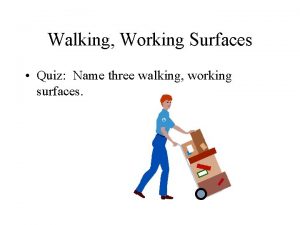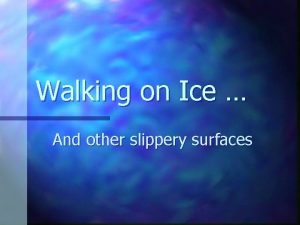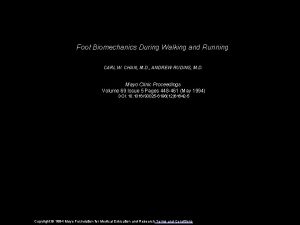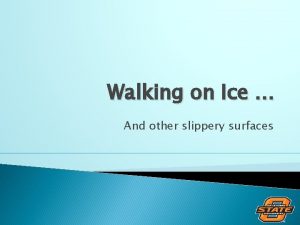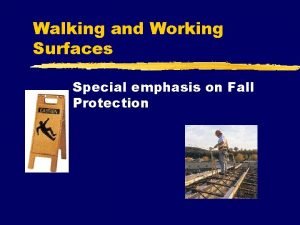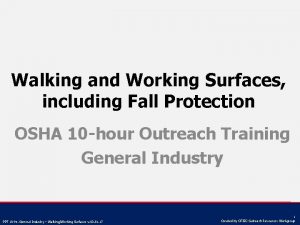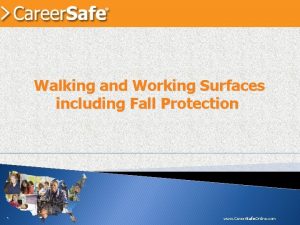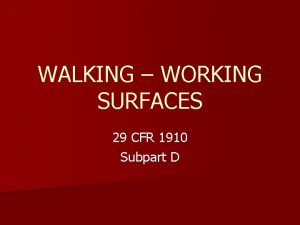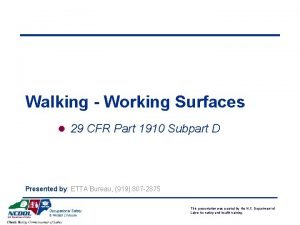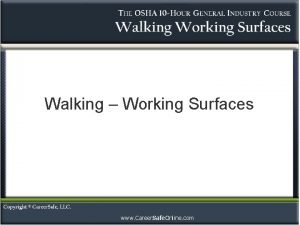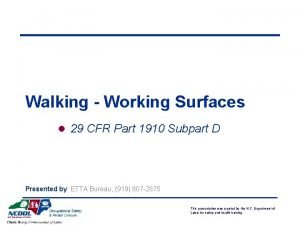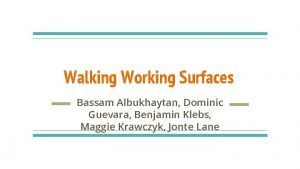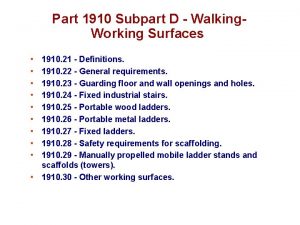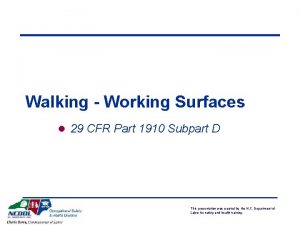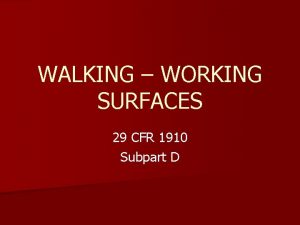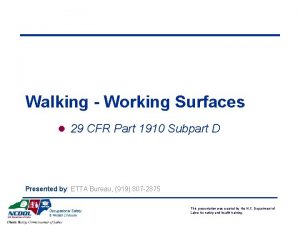Walking and Working Surfaces 1 This material was


















- Slides: 18

Walking and Working Surfaces 1

This material was produced under grant number SH-22248 -11 -61 -F-54 from the Occupational Safety and Health Administration, U. S. Department of Labor. It does not necessarily reflect the views or policies of the U. S. Department of Labor, nor does mention of trade names, commercial products, or organizations imply endorsement by the U. S. Government. 2

Objectives • After this module you should be able to – identify the most common fall hazards associated with your work – take the steps necessary to avoid those hazards

Unsafe Work Practices can be Deadly 4

Improper Use of Step Ladder 5

Danger: Do Not Stand on Top Rung 6

Danger: Broken Ladder 7

8

Extension Ladders • Make sure extension ladder locks are engaged • Never stand on the top three rungs • Don’t lean a ladder against a movable object • Ladder should extend 3 feet from its resting place 9

Ladder Angle • The ladder should be placed according to the Four-to-One Rule • For every 4 feet of rise, the base of the ladder should be 1 foot away from the object the ladder is resting against. 10

Housekeeping 11

Slip Prevention 12

Non-Slip Boots • Slip-resistant soled boots should be worn when working on slippery surfaces. 13

Guarding holes and pits • Provide covers and/or guardrails to protect workers from fall hazards of open holes, pits, an ditches. 14

Activity: Ladder Demonstration • • • Warning labels and placards. Proper pre-use inspection techniques. Proper set-up procedures. Proper use. Handling & Storage considerations. 15

Check Your Knowledge 1. When is it OK to stand on the very top of a step ladder? A. B. C. D. Never When someone holds the ladder. If your boss says you can. If both your hands are free. 16

Check Your Knowledge 2. When using a ladder for access, how far above the surface must the ladder extend ? A. B. C. D. 1 foot. 2 feet 3 feet. 4 feet. 17

Check Your Knowledge 3. What is the best way to protect workers from falling into a hole or pit? A. B. C. D. Placing a warning sign to alert the workers about it. Assigning a guard to monitor the hole or pit. Use a cover and/or guardrail. Use caution tape around the hole. 18
 Walking and working surfaces quiz
Walking and working surfaces quiz Walking working surfaces
Walking working surfaces Walking on slippery surfaces
Walking on slippery surfaces Hot working and cold working difference
Hot working and cold working difference Advantage of hot working process
Advantage of hot working process Machining operations
Machining operations Pembentukan plat pada pengerjaan panas
Pembentukan plat pada pengerjaan panas Smart work vs hard work
Smart work vs hard work Gd and t symbol
Gd and t symbol Example of material culture
Example of material culture The knowledge language values customs and material objects
The knowledge language values customs and material objects Example of material culture
Example of material culture Materials that can be useful and harmful
Materials that can be useful and harmful Jumping third law of motion
Jumping third law of motion Foot biomechanics during walking and running
Foot biomechanics during walking and running Standard costing and variance analysis formulas
Standard costing and variance analysis formulas 7 shape
7 shape 8 vertices, and 6 faces
8 vertices, and 6 faces The relative lightness and darkness of surfaces.
The relative lightness and darkness of surfaces.
